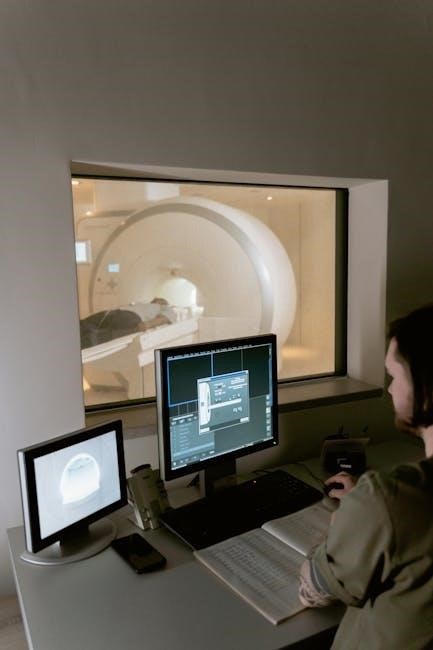The WISC-V is a comprehensive cognitive assessment tool designed to evaluate intellectual abilities in children and adolescents. It measures various cognitive domains to identify strengths, weaknesses, and overall intellectual functioning, providing valuable insights for educational and clinical planning.
Overview of the WISC-V Assessment
The WISC-V, or Wechsler Intelligence Scale for Children, Fifth Edition, is a standardized test designed to assess cognitive abilities in children aged 6 to 16 years. It evaluates various intellectual domains, including verbal comprehension, visual-spatial skills, and working memory. The test is widely used in educational and clinical settings to identify learning disabilities, giftedness, and cognitive strengths or weaknesses. The WISC-V incorporates updated norms and new subtests, reflecting advancements in cognitive psychology and testing methods. It provides a comprehensive profile of a child’s intellectual functioning, aiding in personalized educational and intervention plans.
Importance of the WISC-V in Cognitive Evaluation
The WISC-V plays a crucial role in cognitive evaluation by providing a detailed understanding of a child’s intellectual abilities. It helps identify cognitive strengths and weaknesses, which are essential for tailoring educational strategies and interventions. The test is particularly valuable in diagnosing learning disabilities, such as dyslexia or ADHD, and in determining eligibility for special education services. Additionally, it aids in assessing giftedness and monitoring cognitive development over time. The insights gained from the WISC-V are instrumental in creating personalized learning plans, ensuring that each child receives appropriate support and resources to maximize their potential.

Structure of the WISC-V Test
The WISC-V is organized into primary and ancillary index scores, assessing various cognitive domains such as verbal comprehension, visual-spatial skills, working memory, and processing speed through specific subtests.
Primary Index Scales
The WISC-V includes five primary index scales: Verbal Comprehension Index (VCI), Visual Spatial Index (VSI), Fluid Reasoning Index (FRI), Working Memory Index (WMI), and Processing Speed Index (PSI). Each scale evaluates distinct cognitive abilities. The VCI measures verbal skills like vocabulary and comprehension, while the VSI assesses visual-spatial skills. The FRI evaluates problem-solving and reasoning abilities. The WMI focuses on working memory and attention, and the PSI measures processing speed and efficiency. Together, these scales provide a comprehensive understanding of a child’s cognitive strengths and weaknesses, aiding in tailored educational and clinical interventions.
Ancillary Index Scores
Ancillary Index Scores
The WISC-V includes three ancillary index scores: Nonverbal Index (NVI), General Ability Index (GAI), and Auditory Working Memory Index (AWMI). These scores provide additional insights into specific cognitive functions. The NVI measures nonverbal reasoning and spatial abilities, while the GAI reflects general cognitive abilities without the influence of verbal skills. The AWMI assesses auditory working memory and attention. These scores are derived from select subtests and offer a broader understanding of cognitive strengths and weaknesses. They are particularly useful for identifying specific learning needs and informing targeted interventions. Each ancillary index has a range of 40-160, allowing for nuanced interpretation in educational and clinical settings.
Subtests and Their Functions
The WISC-V comprises 16 subtests designed to measure various cognitive abilities. Subtests like Block Design and Matrix Reasoning assess visual-spatial skills and nonverbal problem-solving. Vocabulary evaluates verbal knowledge and comprehension. Digit Span measures working memory and attention, while Picture Span tests visual working memory. Each subtest targets specific cognitive functions, providing a detailed profile of a child’s abilities. These subtests are grouped under the primary and ancillary indexes, offering insights into strengths and weaknesses. They are essential for understanding cognitive functioning and guiding educational or clinical interventions. The subtests are carefully designed to be engaging and developmentally appropriate for children.

Administration and Scoring of the WISC-V
The WISC-V is administered individually by trained professionals, typically taking 45–60 minutes. Tests are scored using standardized procedures, with raw scores converted to standard scores (mean=100, SD=15). Digital tools facilitate accurate scoring and interpretation.
Test Administration Process
The WISC-V is administered individually by trained professionals in a quiet, standardized environment. The process typically lasts 45–60 minutes, depending on the child’s age and cooperation. Tasks are presented in a specific order, starting with engaging activities to ensure the child’s comfort; Subtests are designed to assess various cognitive abilities, with clear instructions provided for each. Digital tools, like Q-interactive, streamline administration, allowing examiners to easily track responses. The administrator ensures the child understands each task, adapting pacing as needed while maintaining test integrity. This structured approach ensures reliable and valid assessment of cognitive functioning, essential for accurate results and interpretation.
Scoring Methods and Interpretation
The WISC-V uses standardized scoring methods, with raw scores converted to scaled scores (mean=10, SD=3) for each subtest. These are combined to form composite scores for primary index scales, such as the Verbal Comprehension Index (VCI) and Working Memory Index (WMI). The Full Scale IQ (FSIQ) is derived from these indices, providing an overall measure of cognitive ability. Scores are interpreted using percentiles, with higher values indicating greater cognitive functioning. Interpreters analyze score profiles to identify strengths, weaknesses, and cognitive patterns, aiding in educational and clinical decision-making. This systematic approach ensures reliable and meaningful results for understanding a child’s intellectual abilities.
Normative Data and Percentile Rankings
The WISC-V utilizes normative data collected from a large, diverse sample of children, ensuring that test scores are representative of the general population. Percentile rankings are derived from this data, indicating where an individual’s score stands relative to others. A score at the 50th percentile means the individual performed better than half of the normative group. The scoring system is standardized, typically following a normal distribution curve where most scores cluster around the mean. This standardization allows for consistent interpretation of results. The WISC-V’s normative data helps identify cognitive strengths and weaknesses by comparing individual performance to the broader population. Cultural fairness is a key consideration in the sampling process to ensure valid results across diverse groups.

Interpretation of WISC-V Results
The WISC-V assesses various cognitive domains, providing insights into strengths, weaknesses, and overall intellectual functioning. It aids in educational and clinical planning for children and adolescents effectively.
Understanding Index Scores
The WISC-V provides five primary index scores, each measuring specific cognitive abilities: Verbal Comprehension, Visual Spatial, Fluid Reasoning, Working Memory, and Processing Speed. These scores range from 45 to 155, with 100 being the average. Higher scores indicate stronger abilities, while lower scores suggest potential challenges. Ancillary scores, such as the Nonverbal Index and General Ability Index, offer additional insights. Understanding these scores helps identify cognitive strengths and weaknesses, guiding educational and clinical interventions. For example, a high Verbal Comprehension score may indicate strong language skills, while a low Working Memory score could signal difficulties with task persistence or learning.
Identifying Cognitive Strengths and Weaknesses
The WISC-V helps pinpoint cognitive strengths and weaknesses by analyzing performance across five primary domains. High scores in Verbal Comprehension may indicate strong language skills, while low scores in Working Memory could suggest difficulties with task persistence. These insights are crucial for tailoring educational strategies and interventions. For instance, a child with high Fluid Reasoning but low Processing Speed might benefit from extended time on tasks. Understanding these patterns aids in creating personalized learning plans, ensuring each child’s needs are met effectively. This detailed profiling is essential for both educational and clinical settings, providing a clear roadmap for supporting cognitive development. Accurate identification is key to fostering growth.
FSIQ and Its Significance
The Full Scale IQ (FSIQ) is a composite score derived from the WISC-V, representing overall cognitive functioning. It combines performance across five primary domains: Verbal Comprehension, Visual Spatial, Fluid Reasoning, Working Memory, and Processing Speed. FSIQ scores range from 40 to 160, with 100 as the average. This score provides a global measure of intellectual ability, helping to identify whether a child’s cognitive functioning is above, below, or within the average range. FSIQ is crucial for diagnosing intellectual disabilities or giftedness and informing educational and clinical interventions. It offers a snapshot of general intellectual capacity, guiding decisions about support and enrichment programs tailored to individual needs.

Cultural Considerations and Special Populations
The WISC-V incorporates cultural fairness, ensuring accessibility for diverse populations. It accommodates special needs, addressing linguistic and cognitive differences to provide equitable assessment opportunities for all children.
Cultural Fairness in the WISC-V
The WISC-V is designed to ensure cultural fairness, minimizing bias and promoting equitable assessment across diverse populations. It incorporates items and procedures that are culturally neutral, reducing disparities related to linguistic or socio-cultural backgrounds. The test avoids culturally specific content, ensuring that all children, regardless of their cultural identity, have an equal opportunity to demonstrate their cognitive abilities. Additionally, the WISC-V provides accommodations for children with special needs, such as visual or hearing impairments, ensuring inclusivity. These features make the test more accessible and valid for assessing cognitive abilities in a wide range of cultural and demographic groups, fostering a fair evaluation process.
Accommodations for Special Needs
The WISC-V offers various accommodations to ensure equitable assessment for children with special needs. These may include extended time for completion, the use of assistive devices such as magnifying glasses or audio aids, and modified test administration procedures to accommodate physical or sensory impairments. Additionally, the test allows for the use of sign language interpreters for hearing-impaired individuals and provides alternative formats for visually impaired children. These accommodations help level the playing field, ensuring that all children can demonstrate their cognitive abilities fairly, regardless of their physical or sensory challenges, thus providing a more accurate reflection of their true potential.

WISC-V in Educational and Clinical Settings
The WISC-V is widely used in educational and clinical settings to assess cognitive abilities, guide individualized learning plans, and diagnose learning disabilities or cognitive impairments in children.
Role in Educational Planning
The WISC-V plays a crucial role in educational planning by providing insights into a child’s cognitive strengths and weaknesses. It helps educators identify learning difficulties, such as dyslexia or ADHD, and informs the development of Individualized Education Programs (IEPs). The test’s results guide instructional strategies, ensuring tailored support for students with special needs. Additionally, it assists in determining eligibility for gifted programs or special services. By offering a comprehensive understanding of cognitive abilities, the WISC-V supports educators in creating personalized learning plans that foster academic success and address specific challenges, making it an essential tool in educational settings.
WISC-V in Clinical Diagnostics
The WISC-V is widely used in clinical diagnostics to assess cognitive functioning in children and adolescents. It aids in identifying intellectual disabilities, learning disabilities, and attention deficits. By evaluating strengths and weaknesses, clinicians can diagnose conditions like ADHD or dyslexia. The test provides data to inform interventions and treatments, helping professionals develop tailored strategies. Its comprehensive nature ensures accurate diagnoses, guiding therapeutic approaches and educational support. The WISC-V is essential for early identification of cognitive challenges, enabling timely interventions that improve outcomes for children in clinical settings.

Comparison with Other Cognitive Assessments
The WISC-V is often compared to the WISC-IV and WAIS-IV, highlighting advancements in measuring cognitive abilities. It offers improved subtests and scoring models, enhancing accuracy and relevance in modern assessments.
WISC-V vs. WISC-IV
The WISC-V introduces several enhancements compared to its predecessor, the WISC-IV. Key differences include the addition of new subtests, such as Visual Puzzles and Picture Memory, which better assess visual-spatial and memory skills. The WISC-V also incorporates separate indices for Visual Spatial and Fluid Reasoning, providing a more detailed profile of cognitive abilities. Additionally, the test structure has been streamlined to reduce administration time while maintaining reliability. These updates aim to provide a more comprehensive and accurate measure of intellectual functioning in children and adolescents, addressing the evolving needs of clinical and educational settings.
WISC-V vs. WAIS-IV
The WISC-V and WAIS-IV are both widely used intelligence tests, but they cater to different age groups. The WISC-V is designed for children and adolescents aged 6 to 16, focusing on their developing cognitive abilities. In contrast, the WAIS-IV is intended for individuals aged 16 and older, assessing adult cognitive functioning. While both tests measure similar constructs like verbal comprehension and working memory, the WISC-V includes more visually oriented tasks to accommodate younger participants. The WAIS-IV, however, places greater emphasis on complex problem-solving and abstract thinking, reflecting adult cognitive development. These differences ensure each test is tailored to its target population’s unique needs.

Test Preparation and Practice
Practicing sample questions and familiarizing with the test format can enhance performance. Focus on time management and building confidence through structured study routines and mock tests.
Guidelines for Test Preparation
Effective preparation involves understanding the test structure and content. Parents and educators should provide children with practice materials, such as sample questions, to familiarize them with the format and timing. Encouraging a consistent study routine and a calm environment can help reduce anxiety. Mock tests can simulate real conditions, aiding in time management and confidence building. Additionally, ensuring adequate rest and nutrition before the test day is crucial for optimal performance. Professional guidance from psychologists or educators can also offer tailored strategies to address specific needs and improve readiness.
Sample Questions and Practice Tests
Sample questions and practice tests for the WISC-V are invaluable for familiarizing children with the test format and content. These materials often include examples of verbal comprehension, visual-spatial, and working memory tasks. Practice tests simulate real conditions, helping children understand the timing and structure. exposure to similar questions reduces anxiety and builds confidence. Parents and educators can access these resources through official publications or educational websites. Utilizing these tools ensures children are prepared and can demonstrate their abilities accurately. Regular practice also helps identify areas needing improvement, allowing for targeted support. These resources are essential for maximizing readiness and performance.

Criticisms and Limitations
The WISC-V has faced criticism for its scoring models and cultural bias concerns. Some argue it may not fully capture diverse cognitive abilities or high-functioning individuals.
Challenges in High Cognitive Ability Measurement
The WISC-V faces challenges in accurately measuring highly intelligent individuals, particularly those with exceptional cognitive abilities. Research indicates that traditional IQ tests like the WISC-V may lose precision at higher ranges, potentially underestimating true cognitive potential. This limitation arises from the test’s ceiling effects and normative data constraints. For instance, studies suggest that beyond certain thresholds, the test struggles to differentiate between varying degrees of high intelligence. Additionally, the Flynn effect, which notes historical increases in IQ scores, complicates the interpretation of high cognitive abilities. These issues highlight the need for more nuanced assessment tools to better evaluate and understand exceptional cognitive capacities.
Criticisms of Scoring Models
The WISC-V scoring models have faced criticism for their potential limitations in accurately capturing cognitive profiles. Some researchers argue that the test’s scoring assumes a uniform pattern of cognitive development, which may not reflect real-world variability. Additionally, the use of standardization samples and normative data has been questioned for its ability to account for diverse cognitive strengths and weaknesses. Critics also highlight the challenge of interpreting scores for individuals with atypical cognitive profiles, such as those with exceptional abilities or specific learning disabilities. These concerns underscore the need for careful interpretation and consideration of individual differences when using WISC-V scores in clinical or educational settings.

Future Directions and Updates
Future updates may include enhanced digital administration tools and refined scoring models to better capture diverse cognitive abilities, ensuring the WISC-V remains a robust assessment tool.
Expected Revisions and Improvements
Future revisions of the WISC-V may include the integration of new measures, such as enhanced visual-spatial and fluid reasoning assessments, to better capture cognitive diversity. Digital administration tools are expected to improve test accessibility and efficiency. Updates may also focus on refining scoring models to address critiques, particularly for high cognitive ability measurement. Cultural fairness enhancements and expanded accommodations for special populations are anticipated to ensure inclusivity. Additionally, normative data may be broadened to reflect diverse demographic representations, improving the test’s applicability across global populations. These updates aim to maintain the WISC-V as a leading tool in cognitive assessment, addressing both clinical and educational needs effectively.
Technological Integration in WISC-V Administration
The WISC-V has embraced digital transformation, offering online administration options that enhance test accessibility and efficiency. Digital platforms now provide automated scoring, reducing manual errors and improving reliability. Test administrators can utilize digital tools for real-time data collection, streamlining the evaluation process. Additionally, digital stimuli and audio prompts enhance engagement, particularly for visually or auditorily oriented individuals. These technological advancements also facilitate remote testing, expanding access to diverse populations. Furthermore, digital reports generate instant feedback, aiding in quicker decision-making for educational and clinical interventions. Such innovations ensure the WISC-V remains a cutting-edge assessment tool, blending tradition with modern technological advancements for improved outcomes.
